
Stamp collectors love firsts! Doesn't everybody? We all seem
to have a fascination with the first of anything, whether it's the first flower of spring
or winning first place in a contest.
Star light, Star bright, First star I see tonight."
First base. First man on the moon. The first is somehow the best.
The first postage stamp world-wide was the Penny Black of Great Britain, in
1840. Even its promoters were surprised by how quickly the public embraced the strange
concept of sticking a small rectangle of elaborately printed paper onto their
envelopes. The first US stamps were the 5-cent Franklin and ten-cent
Washington of 1847. Their success was more modest at first, but they too caught on,
and soon the first stamp collectors were born.
Some collectors specialize in
collecting ONLY the first stamps, one for each country that has ever issued
a postage stamp. Defining what constitutes such a first can be tricky, though, since
political entities often unite or split. Depending on one's definition of first
stamp, such a collection will total somewhere between 700 and 1,000 items, which
is a small collection, relatively speaking. BUT, since some of those stamps are quite
scarce, only a few complete collections of philatelic firsts can exist.
Other popular firsts include First Day Covers (envelopes with their
stamps cancelled on their day of issue) and First Flight covers (envelopes flown on the first trip of a new air
route, and specially cancelled or cacheted for the occasion).
The USPS has had a lot of "firsts" lately, including both its first
self-adhesive stamp and its first diamond-shaped stamp (both in 1974), its first triangular stamp
(in 1997), and its first semi-postal stamp (in 1998).
What was the first setenant world-wide? Help us answer
this burning question.
Click on any image to bring up a larger high-res version.
Collecting the Firsts
A challenging - and expensive - specialty area is
collecting the first stamp issued by each country of the world.
Here are the first ten world-wide:
| |
Country |
Date |
Description |
2001 Cat. Value Mint/Used |
| 1. |
Great Britain |
May 6, 1840 |
1-penny black |
$3,000 / $180 |
| 2. |
Brazil |
Aug. 1,1843 |
30-reis black |
$3,000 / $550 |
| 3. |
United States |
July 1, 1847 |
5-cent red brown |
$5,250 / $600 |
| 4. |
Mauritius |
Sept. 21, 1847 |
1-penny orange |
$1,100,000 /
$500,000 |
| 5. |
Bavaria |
1849 |
1 kreuzer black |
$650 / $1,800 |
| 6. |
Belgium |
1849 |
10 centimes brown |
$2,250 / $75 |
| 7. |
Spain |
Jan 1, 1850 |
6 cuartos black |
$325 / $11.50 |
| 8. |
Austria |
1850 |
1 kreuzer yellow |
$1,000 / $70 |
| 9. |
France |
1850 |
10 centimes bister |
$1,500 / $325 |
| 10. |
Hanover |
1850 |
1 groschen gray-blue |
$3,000 / $55 |
Sources: Linn's Stamp Almanac, 6th Edition, 2000
2001 Scott Catalog
Don't count on completing a collection of mint Firsts soon,
though, even if you have the money. There is only one mint copy of the Mauritius stamp
in private hands, so you'll have to persuade its owner to sell it to you. Even if you're
willing to settle for used examples, stamps in the $500,000 price range don't change
hands often.
2/18/2003 - a gentleman named Edo Rajh wrote to say -
While there are some first issues that are very expensive, the majority of them are
very affordable. Lots of them are even cheaper than $1. So collecting them is a
challenging specialty, but not so expensive as one might think.
Mr. Rajh is a member of the First Issues Collectors Club, which, according to its very
interesting and informative web site,
promotes the collection of the first postage stamp issued by any nation, province,
city, army or other entity that has, at any time, issued postage stamps; and facilitates
the exchange of information about these issues among stamp collectors.
To visit the web site, CLICK
HERE.
Note their list of the firsts, STARTING
HERE. You will see that their list differs from the one above, since they include
issues from entities such as local and cantonal posts, so one has to exercise one's own
judgment about what constitutes a First.
12/04/2004 -
NEW WEB SITE. I just discovered Nick Blackburn's very informative and entertaining site,
with several pages about firsts, all illustrated with examples -
http://www.snap-dragon.com/first_firsts.htm - The first examples worldwide of various
types of stamps, such as First Airmail, First Booklet, First Multi-lilngual, etc.
I find it fascinating.
http://www.snap-dragon.com/first_issues_guinness.htm - First issues by type for
each country. The list is sequenced by date of each country's first postage stamp,
and goes from Great Britain (1840) through Georgia (1995).
His site shows great promise, so check it out regularly, and send him feedback to
encourage his efforts. He and I are having a discussion about the terms setenant
and composite right now - see
my S page for more.
The Penny Black - World's First Postage Stamp
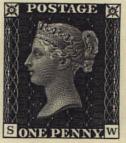
Rowland Hill, who is generally regarded as the father of the postage stamp, was the
motive force behind the issuance of the Penny Black, but his campaign was not for stamps
per se, rather he sought to establish a uniform prepaid rate of one penny per
half-ounce
for a letter sent anywhere within the British Isles, and the use of stamps and
stamped envelopes (see "M is for Mulready") was a
logical necessity to make that scheme practical. The new rate went into effect on May 6,
1840, and both it and the Penny Black were immediate successes.
There are several notable features of the Penny Black. First, each stamp bears a pair
of letters, in the bottom left and right corners, which denote its position in the sheets
of 240 (12 x 20) in which the stamp was produced. The letter on the left is the row
within the sheet (A through T), and the letter on the right is the position of the stamp
in its row (A through L). This was intended as a security and accounting device, but did
not last long, since it made it necessary to engrave at least part of each position in
the sheet separately. It has been a great help to collectors in plating the issue,
however.
You may note as well that there is no country name on the stamp. Since no one else had
issued stamps yet, it did not occur to the creators that it might be necessary to
distinguish their product from others. In recognition of its status as the first nation
to issue stamps, Great Britain was given by international agreement the unique right to
continue to issue its stamps with no country name (all other countries that wish to send
their mail internationally must place the name of their country on each stamp). However,
all GB stamps are immediately recognizable, since the head of the reigning monarch of its
date of issue appears on every stamp.
There is a story that Rowland Hill was inspired to champion cheap prepaid postage by
witnessing a scene in a country village - the postman presented a letter to a village
maiden, who glanced at it, then handed it back, saying she could not afford to pay the
postage. Hill, in sympathy, paid the postage and handed it to her. Once the postman
had left, the girl confided to Hill that she did not want the letter at all, since the
message it conveyed was written in a private code on the exterior, and she had read it
when the postman first handed it to her. Whether the story is true or not, it
illustrates the major weaknesses of the older system, in which rates were very high, so
most mail was sent Due, and the recipient was under no obligation to pay it.
THE POSTAGE DUE PRESIDENT
|
The problems with sending mail Due were equally serious
in the U.S., where in 1848, Zachary Taylor did not know he had been nominated for President
for several weeks after the nomination took place, until someone arrived to tell him in
person - he had refused several letters conveying the news, because he did not care to
pay the postage due!
This seems incredible in these days of instant world-wide
communication, but demonstrates not only the disadvantage of the postage rules in effect
at the time, but the different attitude of those times - people valued their privacy. It
must be said as well in Taylor's defense that he had been receiving so much Due mail from admirers
that he was forced to instruct his postmaster to reject all unpaid mail.
Moreover, he had not sought the nomination, and was not expecting it.
Even after the introduction of postage stamps in the U.S., their use was not mandatory
for eight more years. One famous consequence of this was that in 1848, Zachary Taylor
did not know he had been nominated for President
for several weeks after the nomination took place, until someone arrived to tell him in
person - he had refused several letters conveying the news, because he did not care to
pay the postage due! This seems incredible in these days of instant world-wide
communication, but demonstrates not only the disadvantage of the postage rules in effect
at the time, but the different attitude of those times - people valued their privacy. It
must be said as well in the famous man's defense that he had been forced to instruct his
postmaster to reject all unpaid mail. Taylor was receiving so much from admirers that
the cost of the postage due was more than he could afford to pay!
Moreover, he had not sought the nomination, and was not expecting it.
First US Postage Stamps - 1847

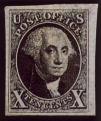
These are the first two US stamps, issued in 1847. The one on the left is generally
called the first, but in fact they were issued at the same time. Like most early stamps,
they were issued imperforate, and had to be separated with scissors, or torn; moreover,
they were printed with relatively small separation between the images, making it
difficult today to find a good used copy, i.e. one that does not have a part of the
design cut off. Below are additional scans from auction catalogs of actual examples of
some of the surviving copies.
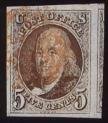
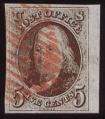


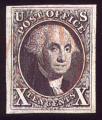
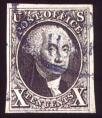
No, it's not your monitor, those images - and the actual stamps - are dull and muddy;
yet these are considered Gem examples. I don't know why production quality was so poor -
is it that security engraving was still a relatively new process? That first GB stamp
above, seven years earlier, looks pretty good. Was it that the U.S. was still somewhat
primitive, lacked the sophistication to produce a quality product? Or that Congress was
too cheap to pay for something better? Or perhaps Americans of the period regarded such
frills as too elitist? Send opinions to the webmaster at posterstampcc@gmail.com.
MORE FIRSTS.
All Letter images Copyright © 1997, 2000, SF chapter of AIGA
All text Copyright © 2000, William M. Senkus
Send feedback to the webmaster:
CLICK HERE
Revised -- 12/03/2004















